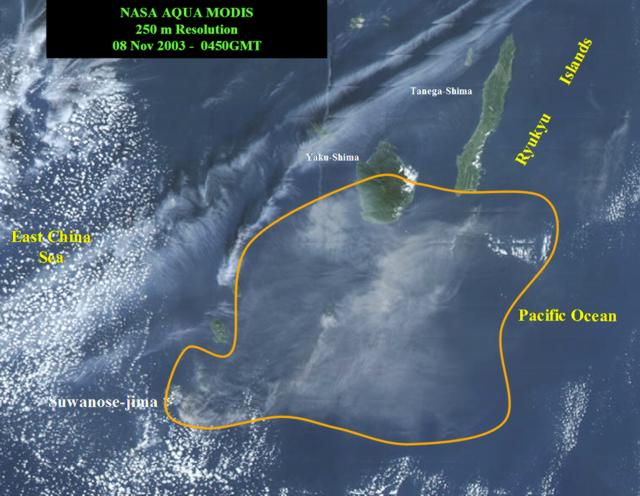Report on Suwanosejima (Japan) — March 2004
Bulletin of the Global Volcanism Network, vol. 29, no. 3 (March 2004)
Managing Editor: Richard Wunderman.
Suwanosejima (Japan) Sporadic eruptions in 2003 and in January 2004, one to 2.4 km altitude
Please cite this report as:
Global Volcanism Program, 2004. Report on Suwanosejima (Japan) (Wunderman, R., ed.). Bulletin of the Global Volcanism Network, 29:3. Smithsonian Institution. https://doi.org/10.5479/si.GVP.BGVN200403-282030
Suwanosejima
Japan
29.638°N, 129.714°E; summit elev. 796 m
All times are local (unless otherwise noted)
Suwanose-jima volcano was last reported in BGVN 28:04, when activity was noted in September and December 2002, with thermal anomalies continuing into January 2003. HIGP MODIS thermal imagery revealed only one alert in the year to 13 April 2004, that being on 4 July 2003. NASA Terra and Defense Meteorological Satellite Program imagery dated 7-8 November 2003 showed an ash plume rising from Suwanose-jima to an estimated height of 2,400 m (figure 10) on those days.
 |
Figure 10. Ash plume from Suwanose-jima on 8 November 2003 imaged by the MODIS instrument on the NASA AQUA satellite. Courtesy Defense Meteorological Satellite Program (DMSP) and Charles Holliday. |
According to Tokyo VAAC reports, using information from the Japanese Meteorological Agency, explosions also took place at Suwanose-jima on 15 December 2003 at 1946, and 21 December at 1828, each of which produced plumes to an unknown height. The VAAC reported several small emissions on 27 and 28 December, again rising to unknown heights and an eruption on 28 December at 0820 rising to ~ 1.5 km altitude and extending E. On 2, 4 and 21-22 January 2004 small explosions produced ash plumes to unknown heights.
Geological Summary. The 8-km-long island of Suwanosejima in the northern Ryukyu Islands consists of an andesitic stratovolcano with two active summit craters. The summit is truncated by a large breached crater extending to the sea on the E flank that was formed by edifice collapse. One of Japan's most frequently active volcanoes, it was in a state of intermittent Strombolian activity from Otake, the NE summit crater, between 1949 and 1996, after which periods of inactivity lengthened. The largest recorded eruption took place in 1813-14, when thick scoria deposits covered residential areas, and the SW crater produced two lava flows that reached the western coast. At the end of the eruption the summit of Otake collapsed, forming a large debris avalanche and creating an open collapse scarp extending to the eastern coast. The island remained uninhabited for about 70 years after the 1813-1814 eruption. Lava flows reached the eastern coast of the island in 1884. Only about 50 people live on the island.
Information Contacts: Japan Meteorological Agency (JMA), Volcanological Division 1-3-4 Ote-machi, Chiyoda-ku, Tokyo 100, Japan (URL: http://www.jma.go.jp/); HIGP MODIS Thermal Alert System, Hawaii Institute of Geophysics and Planetology, School of Ocean and Earth Science and Technology, University of Hawaii at Manoa (URL: http://modis.higp.hawaii.edu/); Charles Holliday, Air Force Weather Agency (AFWA), Satellite Applications Branch, Offutt AFB, NE 68113-4039, USA.

